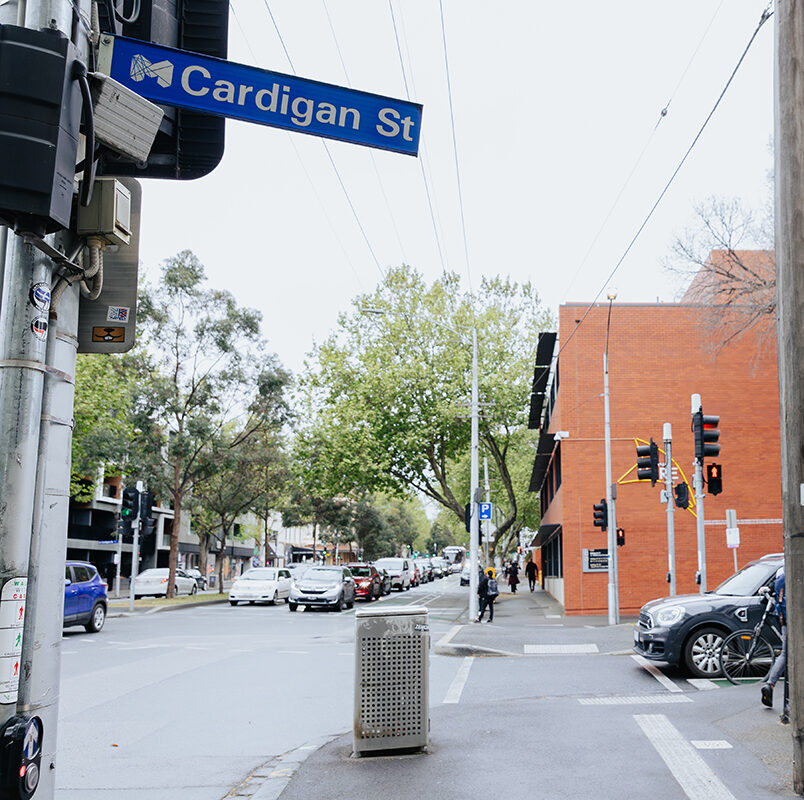
Photo: Courtesy of Maud Cassaignau.
Meet one of RMIT PlaceLab’s Academic Collaborators, Dr. Maud Cassaignau. Maud is an urban, landscape and architectural designer and researcher working in RMIT’s School of Architecture and Urban Design. After working in leading practices in Europe and the US, she started realising projects within her own practice, XPACE.
Maude has taught at the ETH Zurich, the University of Applied Sciences Western Switzerland, Monash University, and now RMIT where she holds a senior lecturer position in landscape architecture. Her research – focusing on inclusive urban transformation, urban landscapes, climate adaptation, urban heat island effect, water sensitive design and urban wilding, has been nominated for national and international awards, published in books, and presented at Melbourne Design Week and the Venice Biennale.
We are pleased to work with Maude, her landscape architecture colleagues, Heike Rahmann and Brent Greene and their students, around considering possible urban wilding efforts for along Cardigan Street as part of our Research Project ‘Cardigan Commons’.

Cardigan Street. Photo by Dijana Risteska.
“The assumption is that wild revegetation strategies are more resilient and self-sufficient, need less maintenance, and can better resist to climate fluctuations and change. Simultaneously they will offer more appealing sights, moments of discovery and fascinating spaces to visitors.”
What drew you to collaborate with RMIT PlaceLab on its ‘Cardigan Commons’ Research Project?
When starting the collaborative research about urban wilding: aiming to test how wilding strategies could be implemented in a local urban context, we were keen to find opportunities to do this close to the CBD and RMIT University where we work. We wanted to be able to visit it often, do something close by, and enjoy the outcomes. PlaceLab’s dedicated aim of activating the Cardigan Street precinct and its strong connection with local communities offered an ideal partnership for developing a real-world intervention on campus that meaningfully involves users.
Wilding is an approach to urban vegetation that does not focus on single species but instead aims to implement whole ecosystems of plants, animals, fungi, soil, and air, within cities. It builds on the idea that plants do not thrive in isolation but need symbiotic relationships with other species, to best develop. The assumption is that wild revegetation strategies are more resilient and self-sufficient, need less maintenance, and can better resist to climate fluctuations and change. Simultaneously they will offer more appealing sights, moments of discovery and fascinating spaces to visitors.
You’re also working together on a Student Design Studio called ‘Rewilding the Campus’ in partnership with RMIT PlaceLab and Salad Dressing Landscape Architects Singapore. Can you share a little more about what inspired this partnership with Salad Dressing and how these partnerships have inspired / align with the students’ work?
I have pursued the model of doing research alongside Research-Design studios for 10 years, and this model has been very successful in creating synergies between teaching and research. Having your ideas challenged by students helps sharpening your thinking while students profit from their studios having real world implication and being exposed to innovative research and great collaborators. I theorised and reflected this model through my PhD at RMIT University.
Salad Dressing are cutting-edge practitioners from Singapore, who have a fantastic track record of wilding projects in Singapore. Collaborating with them has been a great opportunity to test how such concepts of wilding could translate in a local context with very different urban, climatic, and cultural conditions. This is interesting for both partners: RMIT and Salad Dressing.
The Studio, testing such strategies at urban and larger scale provided a good opportunity to spark discussions about different approaches and local differences.
Can you tell us a bit about your own research and how it intersects with the themes and objectives of the ‘Cardigan Commons’ Research Project?
My own research revolves around developing urban strategies and designs that retrofit cities in ways that better address climate (urban heat, flooding, drought), biodiversity and health challenges (physical, mental, wellbeing, pollution, opportunities for movement and socialising), while offering exciting spaces and opportunities for discovery. How can such strategies be developed at different scales, use existing urban pockets of space that can be progressively connected into larger networks for better pedestrian accessibility, air movement, ecological connection and water management?
How can these be deployed in a strategic and progressive manner to address our huge challenges of liveability?
Working on prototypes for wilding at different scales alongside urban strategies offers insights into how to best develop wilding at different scales.
What would your ideal Cardigan Street look like? What would make it possible?
The ideal Cardigan Street Park would offer extensive areas of lush vegetation, comprised of different plants, offering habitat to a variety of endemic species and animals that already exist in our cities but often struggle due to restricted habitats: birds, pollinators, bats, lizards, possums, critters, worms, fungi – just to name a few. These wild ecosystems would show seasonal change, and spontaneously develop over time. They would attract different non-human and human visitors, respond to climate, and offer moments of discovery, connection, respite. Grasslands and boardwalks would offer space for passage, socialising, outdoor study, meeting to local communities, and RMIT. Water bodies collecting rain and roof water would refresh surroundings. Teeming with water creatures they would be attracting drinking birds, bees and dragon flies. It would form a little urban oasis.
What are some ways we can consider greening urban spaces – both collectively and individually?
We should see the multiple benefits of ‘greening’ and wilding: They can bring us attractive and fascinating spaces for multiple outdoor activities, socialising, and respite. They can give us connections, and benefit our wellbeing, physical and mental health.
They can cool the city through evaporative cooling and prevent flooding, and later deal with drought by capturing rainwater. They also benefit the attractiveness and value of surrounding properties. We are convinced that wilding can provide a more interesting, resilient and less maintenance-intensive way of greening. It has many benefits thus should make investing in wild urban greenspaces a no-brainer.